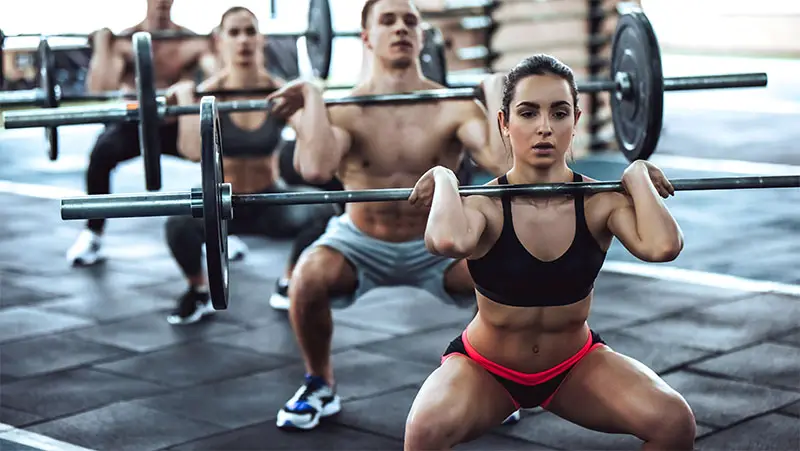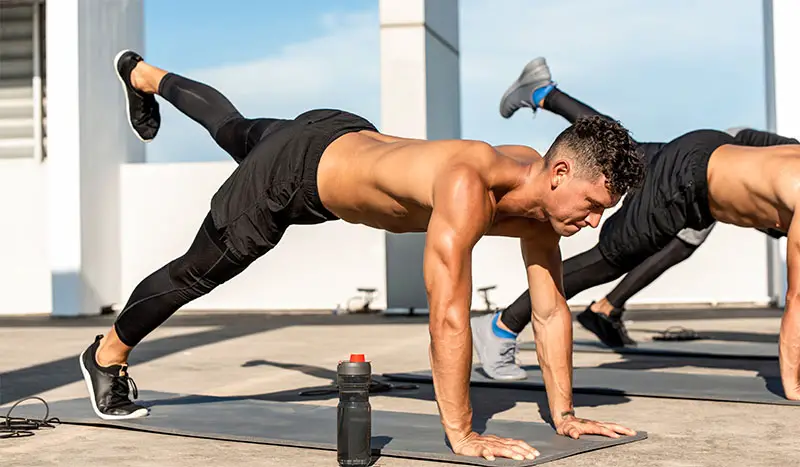Crossfit and high-intensity interval training (HIIT) are both popular and efficient workouts.
It is hardly surprising that both have many similarities. For example, both Crossfit and HIIT are excellent for weight loss, added strength, and a terrific exercise in an hour or less.
However, the two training regimens are not identical. And they each provide distinct benefits that may make one more desirable, depending on your fitness objectives.
So what’s the better workout in the HIIT vs Crossfit debate? Here’s everything you need to know.
What Is HIIT?

HIIT includes brief explosions of intense exercise alternated with periods of low intensity recuperation.
Typically, the length of HIIT exercise is 10 to 30 minutes. Despite the short workout periods, the health effects are comparable to twice the length of other exercises.
The actual activities may vary, including running, cycling, jumping rope, or other bodyweight workouts.
Who Can Do HIIT?
HIIT is a great exercise choice for individuals of all ages in good physical condition. As long as someone has no medical reason to not exercise, they likely can perform HIIT.
However, always consult with your doctor before starting a new exercise program. If you have any of the below conditions, it is always best to check with your doctor to be safe.
- Heart problems
- Asthma
- High blood pressure
- Diabetes
- Other previous injuries
How Many HIIT Workouts Per Week?
Two or three days a week is a do-able amount of HIIT, as long as you build in 24 hours of recovery between sessions.
If you want to workout four times a week, we recommend two HIIT and two strength-training sessions. Whether you go whole-body or just upper body or legs on the strength training days is up to you.
Keep in mind, if you perform leg-intense strength training one day, it’s going to be tough if you have HIIT sprints the next day. Try to plan a day of recovery or yoga for the best outcome.
HIIT Benefits
You can rapidly burn calories using HIIT. For example, one research compared calories spent in HIIT for 30 minutes, lifting weights, jogging, and cycling. Researchers found HIIT used between 25 and 30 percent more calories than conventional exercises.
Another way HIIT helps you burn calories occurs after you’re done. Several studies have shown the remarkable potential of HIIT to boost your metabolic rate hours after a workout.
Example HIIT Workouts
- Hand-Release Push-Ups – Start in a standard push-up posture and drop your body to the ground. While on the ground, lift your hands off the ground for a second, exhale, and push your body back up all the way. If you have to change the motion, go down to your knees.
- Russian Twists – Russian twists are HIIT training that improves your core. Sit on the floor, contacting the floor with your heels or lifting them slightly off the floor (advanced). Keep your hands together in front of you and twist your torso from side to side.
- Mountain Climbers – Start this exercise in the pushup position with hands shoulder width apart. Bend your left knee and bring it to the middle of your chest, then quickly switch, returning your left knee to the pushup position and bringing your right knee forward. Continue this motion, alternating which knee is being brought forward.
What Is Crossfit?

Crossfit is a high-intensity fitness program that incorporates several sports and strength exercises. Some example Crossfit exercises are squats, push-ups, pull-ups, burpee box jumps and lunges. People who perform Crossfit workouts do workouts of the day or WODs.
Who Can Do Crossfit?
Everyone can practice Crossfit regardless of age and fitness levels. They customize the approach to help each individual become more fit. Grandparents and Olympians may do the same exercises – just in modified forms.
How Many Crossfit Workouts Per Week?
You can perform Crossfit 3-5 days per week. It’s best to perform Crossfit and then rest the next day, allowing your muscles to repair. You should not exceed 5 days in a row, as your body needs at least one day of recovery per week.
Crossfit Benefits
Crossfit offers many benefits. Here are just a few: increased overall strength, muscle growth, improved endurance, cardiovascular health, increased agility & flexibility, burns calories and therefore weight loss.
Other benefits of Crossfit are that it is a community exercise. People of like minds come together to work out. They have friendly competitions and we should not underestimate the support network.
Example Crossfit
- 10 to 1 WOD countdown – Do ten kettlebell swings, each with a moderate weight, followed by ten stumps (hold a light dumbbell in front of your chest with both hands; squat with a dumbbell in place, then stand straight while raising the dumbbell overhead.) Do nine of each, then eight, and so on, down to one of each.
- Simple Workout Burpee – This is a straightforward Crossfit exercise, where you have to do as many burpees in eight minutes as you can.
- WOD Body Weight – In this Crossfit exercise, you will perform 3 out of 10 rounds of air squats, push-ups, burpees, or ring bows as intensely as you can.
HIIT vs Crossfit – Differences

HIIT focuses primarily on scheduled intensity intervals and brief recovery periods. An example would be to do a set of mountain climbers for a minute, then rest for 15 seconds, then perform 2 more sets.
Crossfit workouts follow a defined period or a set of repetitions. Crossfit provides training objectives, such as the number of repetitions to accomplish in a certain period.
Crossfit training offers a more competitive edge. Many athletes take part each year in the Crossfit Open and the Crossfit Games. Even in daily WODs, trainers publish results on internal boards. So there’s always friendly competition with your peers.
HIIT vs Crossfit – Similarities
HIIT vs Crossfit definitely has similarities. One of Crossfit’s most obvious parallels with HIIT is its circuit-like regimens. Many of the workout programs include cardio and brief rest periods to improve endurance, strength, and agility.
It is essential to remove monotony from exercises in both HIIT and Crossfit. The “continuously varied” motto of Crossfit can also be seen in HIIT. Workouts vary every day, and participants need to learn to adapt. This helps to increase fitness levels. To see the most results, participants in both regimens should use a coach or trainer.
Both kinds of training require a commitment and drive that other workout regimens may not have.
Crossfit and HIIT are both for individuals who desire something more to accomplish. Whether it’s general health, improved muscular tone, strength gains, or otherwise, just showing up and moving won’t cut it during a Crossfit or HIIT session.
HIIT vs Crossfit – Which Burns More Calories?
HIIT is more focused on “burning calories” than Crossfit. As weight loss training, HIIT is better suited.
The creators of Crossfit did not intend for it to be used solely for weight loss. Athletes with daily weight-lifting activities, mobility exercises, and WODs build muscular bodies and therefore keep their optimum weight. But the emphasis is not on weight loss but on strength and fitness.
Why Do HIIT & Crossfit Instead of Other Types of Training?

HIIT should help you see the most significant muscle tone and weight loss as quickly as possible. This is because HIIT activities burn a lot of calories. The results may vary, but after a few weeks, you should see a change.
Although other fitness regimens will also burn calories, the effects may not be as apparent as Crossfit or HIIT and may require a much longer time to see the results.
Wrap-Up
So which workout wins in the HIIT vs Crossfit competition? Well, it really depends on what your goal is. If you want to focus on gaining overall strength and muscle mass, then Crossfit is probably what you should work on. But, if your goal is to burn calories and lose weight while toning muscles, do HIIT training. Or, you could have the best of both worlds and do both! 🙂
